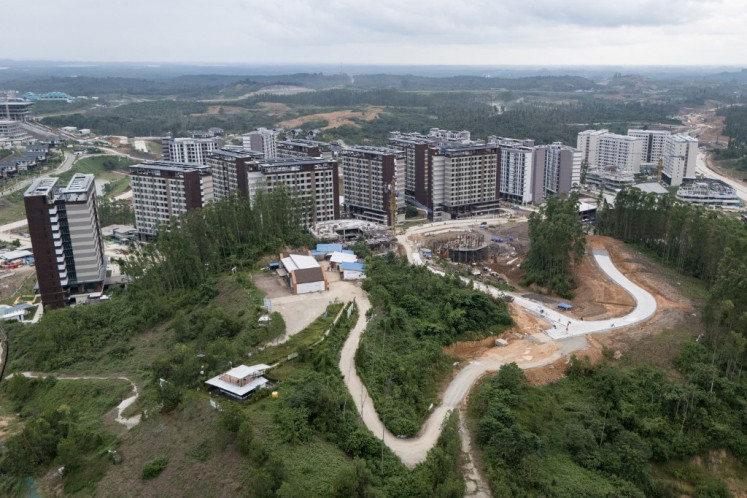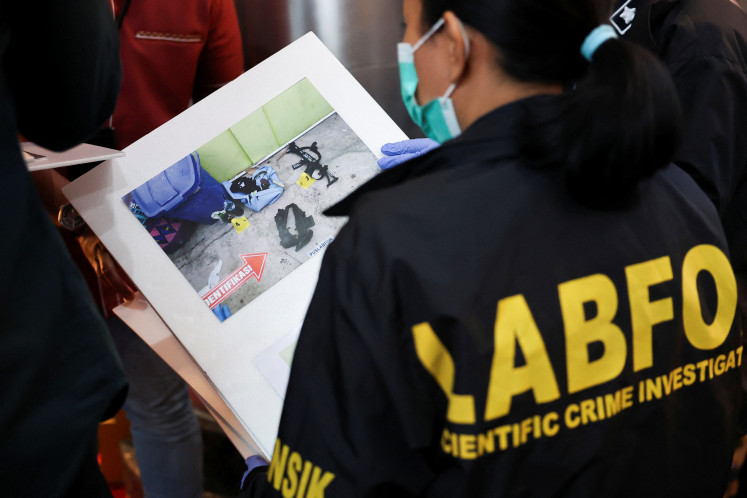Popular Reads
Top Results
Can't find what you're looking for?
View all search resultsPopular Reads
Top Results
Can't find what you're looking for?
View all search resultsFusion the BALAM way
“Fusion” is word that motivates controversy among many lovers of traditional arts, including performing arts like music and dance
Change text size
Gift Premium Articles
to Anyone
“Fusion” is word that motivates controversy among many lovers of traditional arts, including performing arts like music and dance.
A force of nature: BALAM Dance Theatre founding director Islene Pinder rehearses for her return to the stage at the age of 81 after a decade-long hiatus from performing.
BALAM Dance Theatre’s founding director Islene Pinder claims the word proudly for her company’s style of dance and collaborative work with Bali’s Semara Ratih Gamelan.
BALAM and Semara Ratih are in the midst of a busy Bali 2010 rehearsal season with shows scheduled for today in Tegalalang, Aug. 13 at the Pura Dalam of Padangtegal, Aug. 15 in the village of Kedisan, Aug. 17 at the Pura Desa of Kutuh, and Aug. 21 at the Pura Dalem of Ubud.
BALAM’s artistic director Carlos Fittante will also perform his signature solo piece titled Amantes at Case Luna in Ubud on an upcoming Sunday.
“The Balinese want to see it. The tourists want to see it,” said Pinder at a recent rehearsal at the Ubud home of A.A. Gede Anom Putra. Anom Putra is artistic director of Semara Ratih Gamelan, a celebrated Balinese dancer and also Pinder’s godson. Pinder, also known as Ibu-lene, met Anom Putra as a child in the 1970s during her first visits to Bali.
“There’s a lot of commotion these days about [fusion in performing arts]; a big commotion about whether you are ‘traditional’,” Pinder went on.
“Oh, my god, you’re not traditional, taking this material and using it,” said Pinder, representing the views of traditionalists. “It’s been in the news a lot.”
On the other hand, she thinks people are ready to accept fusion dance styles.
Pinder’s history in Bali began in 1973 when she visited as a tourist. Within two years, she came back on a grant to study Balinese dance and in 1979, founded BALAM Dance Theatre (BALAM). BALAM describes its repertoire as reflecting the rich diversity of New York’s eclectic dance community including Balinese, ballet, modern, Spanish, Lester Horton, Baroque, Belly Dance, Latin, hip-hop, drag, Noh, yoga and karate movement styles.
Pinder described Balinese dance as “crisp” and as a modern dancer, said she is “well suited to crispness”. She spent her career in New York dancing traditionally male roles in Balinese dance including the Topeng, the Baris and the Jauk.
“Maybe that’s why I’m 81 and still rehearsing,” she said with a laugh.
Incredible as it may sound, this octogenarian is making a comeback as a dancer during the 2010 Bali tour after a decade-long hiatus.
“They’re ready for us,” agreed BALAM’s artistic director Carlos Fittante, a Spanish American whose own multicultural dance background spans from ballet to Baroque and includes contemporary martial arts training.
Good times: BALAM Dance Theatre members enjoy a rehearsal in Ubud.
Fittante even trained in traditional Spanish bullfighting to refine his performance of the piece “Sunda-Upasunda — NYC Brothers”. This new piece is a duet with BALAM’s Toshinori Hamada, which premiered in Ubud’s Pura Desa of Kutuh on Aug. 3, 2010.
Hamada choreographed “Sunda Upasunda — NYC Brothers” in anticipation of BALAM’s 2010 Bali tour.
He mentioned jam karet (rubber time) — meaning you can arrive within a certain time frame as opposed to a precise time — as one cross-cultural difference to be overcome in communicating and scheduling collaboration across two continents.
Susan Allen, who teaches performing arts at an international school in Bali, attended the Aug. 3 premiere of “Sunda Upasunda — NYC Brothers” .
“The dance involved a simple but effective use of mask and costume and one piece of red material, which served, in my view, to symbolize power,” said Allen. The gamelan group also chanted, produced sound effects using their voice and played instruments in a non-traditional manner, she went on.
“The use of mask, simple material and movement was compelling and resonated the essences of searching, achievement, egotism and passion.”
Sleeping Buddha and Harlequin’s Charade are two other new works scheduled for premiere on Aug. 15 in the village of Kedisan.
Pinder emphasized company dancers’ opportunities to grow professionally with the group as artists and choreographers.
“This will bring them to a new level,” said Pinder. She noted how Anom Putra’s had taken a similar approach when directing Semara Ratih Gamelan.
Rehearsal time: Dancers Shelley Lynn Cummins, Toshinori Hamada and Carlos Fittante rehearse BALAM’s signature piece Ramayana-Abduction of Sita, at the family home of Semara Ratih Gamelan’s artistic director Anom Putra in Ubud.
“The fact that BALAM’s programming is very exciting and attracting lots of Balinese as well as tourist audiences here in Bali says something about what’s happened to Bali since we were here in 2006,” said Fittante.
“We always had great responses but [broadening interest] is a statement about how the world is coming together.”
Semara Ratih Gamelan, which currently consists of 21 musicians, has been collaborating with BALAM for three decades. Anom Putra highlighted the professionalism of his musician colleagues facilitated the collaboration.
Upcoming Bali performances this week with BALAM and Semara Ratih Gamelan also include signature collaborative works Ramayana-Abduction of Sita and Tigerlily and the Dragonfly. “Ramayana-Abduction of Sita” was a decade in the making, “as is fitting for an epic”, said Fittante.
“The Balinese dance style is very theatrical, and this idea of really getting all of your chi into your extremities and the details of your eyes and fingers. We don’t get to work with those points in conventional Western dance forms as much.”
BALAM’s version of the Ramayana features “the large, sweeping movements and freedom of the West joining with the powerful, still detail of Balinese dance,” according to Fittante. “That’s what attracted me [to it].”
Then there’s also the Balinese ritual, cultural and spiritual belief aspect of the dance, Fittante added.
“We are reminded that dance has those roots,” said Fittante, “not that we have to be of any particular background.”
The piece features four parts, with different styles of movement expressing those archetypes — ballet for the prince and princess and karate for the powerful and demonic.
The golden deer is performed by Shelley Lynn Cummins, whose background spans yoga and belly dance as well as ballet. Cummins also conceived and choreographed Sleeping Buddha based on the life of the Buddha.
Tigerlily and the Dragonfly was premiered in Bali in 2000 as part of the International Bali Arts Festival hosted in Denpasar.
This duet featuring Fittante and ballerina Robin Gilbert Campos returns to Bali in 2010.
After the series of performances with BALAM, Semara Ratih Gamelan will depart for a European tour.
The current tour schedule includes performances in the Netherlands on Sept. 9 and 10, Belgium on Sept. 11 and 19, Germany on Sept. 12 through 18 and Turkey on Sept. 23.
Pinder said that the magical energy of Bali is more than just a cliché; it is palpable in everything from daily offerings as natural works of art to the hypnotic sounds of gamelan.
“As a dancer, you hear the music differently,” said Pinder, and Bali takes on “a whole new allure”.
— Photos by Glenn Chickering












